Shading correction
The shading correction can be used in conjunction with the automatic sun function or louvre adjustment. The function checks whether a window or a window group that is assigned to a room, for example, is temporarily placed in the shade by surrounding buildings or parts of its own building. Sun shading for windows that stand in the shadow of surrounding buildings or trees is not necessary and may even be disturbing under certain circumstances. On the basis of data entered regarding the facade and its surroundings, the shading correction determines which parts of the front are in the shade. Hence, it is then possible to decide whether the sun protection should be active for individual windows or window groups.
Apart from the current position of the sun, the shading of the individual windows depends on three things:
- the orientation of the facade
- the position of the windows
- the positioning of the shading objects
The following illustrations are intended to describe these interrelationships and to present the parameters to be entered.
Orientation of the facade
Observation from above
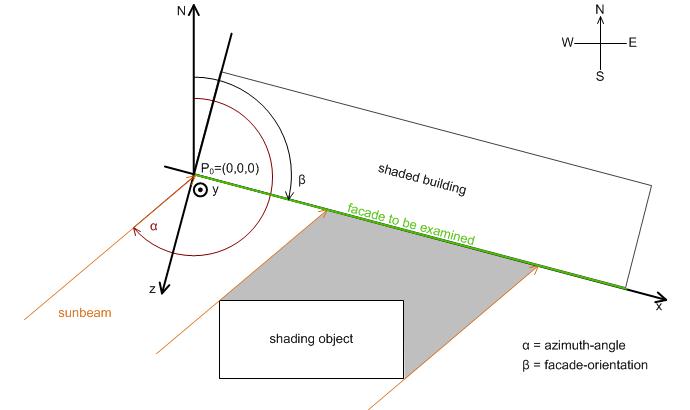
For the pure observation of the shadow thrown on the facade, a two-dimensional coordinate system is ultimately required, therefore the x and y axis were placed on the facade. The zero point is thereby at the bottom left on the base, as if one were regarding the facade from the front. For the calculation of the shading objects the Z component is then also added. Its axis points from away the facade and has the same zero point as the X and Y axis.
In the northern hemisphere, the horizontal sun position (azimuth angle) is determined from the north direction by definition. The facade orientation is likewise related to north, wherein the following applies to the line of sight from a window in the facade:
Line of sight | Facade orientation |
|---|---|
North | β=0° |
East | β=90° |
South | β=180° |
West | β=270° |
In the southern hemisphere is the sun path is the other way round: Although it also rises in the east, ad midday it is in the north. The facade orientation is adjusted to this path:
Line of sight | Facade orientation |
|---|---|
South | β=0° |
East | β=90° |
North | β=180° |
West | β=270° |
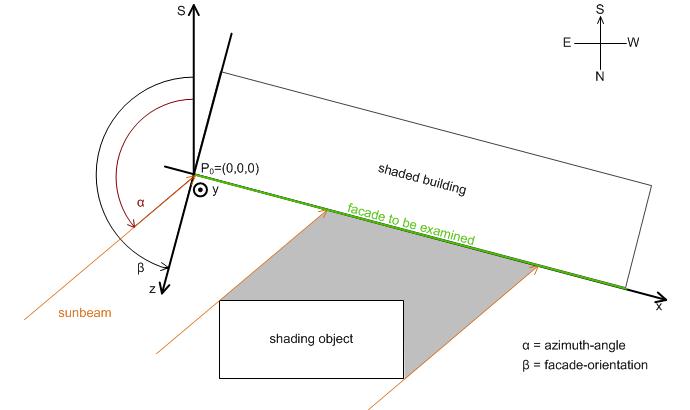
For convenience, the other explanations refer to the northern hemisphere. The calculations for the southern hemisphere are analogous. When the function block FB_BA_ShdCorr (shading correction) is parameterised they are activated through a boolean input, bSouth
The following two illustrations are intended to further clarify the position of the point of origin P0 as well as the orientation of the coordinate system:
Observation from the side
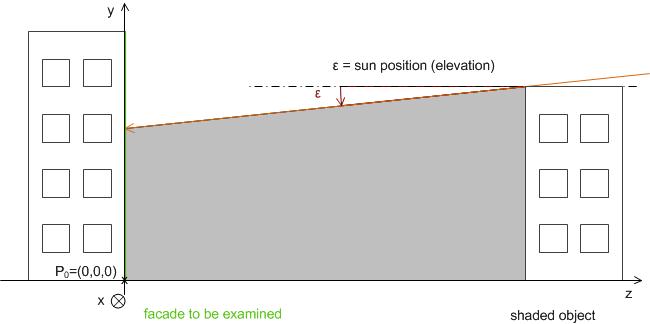
The angle of elevation (height of the sun) can be represented using this illustration: this is 0° at sunrise (horizontal incidence of light) and can reach maximally 90°, but this applies only to places within the Tropic of Cancer and the Tropic of Capricorn.
Observation from the front
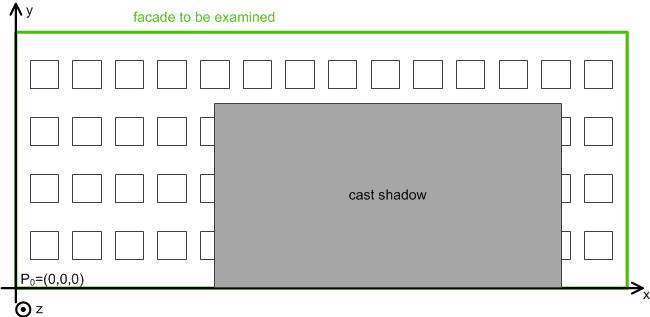
Here, the position of the point of origin, P0, at the bottom left base point of the facade is once more very clear. Beyond that the X-Y orientation is illustrated, which is important later for the entry of the window elements.
Position of the windows
The position of the windows is defined by the specification of their bottom left corner in relation to the facade coordinate system. Since a window lies flat on the facade, the entry is restricted to the X and Y coordinates.
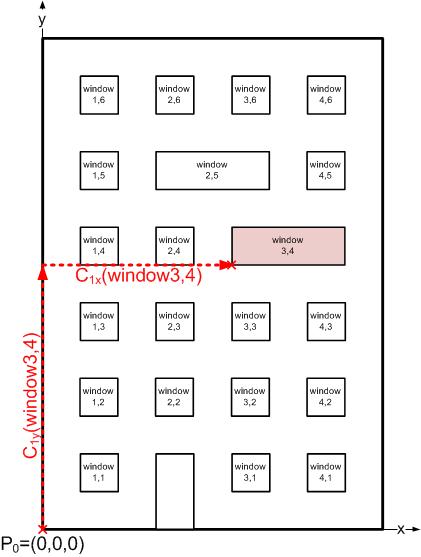
The width and height must additionally be specified.
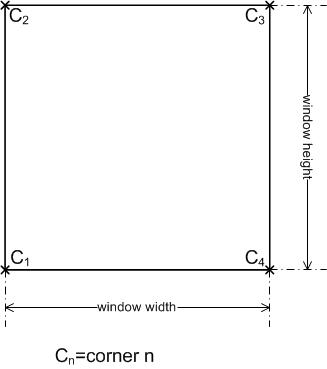
The position of each window corner on the facade is determined internally from the values entered. A window is in the shade if all corners lie in the shade.
Positioning of the shading objects
When describing the shading objects, distinction is made between angular objects (building, column) and objects that are approximately spherical (e.g. trees). Angular objects can be categorised according to the shadow they cast into square, shadow-casting facades, wherein one must consider which ones cast the main shadows over the course of the day:
Morning/midday
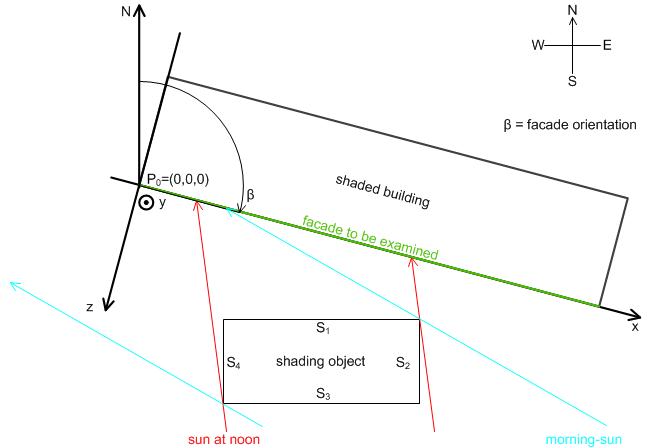
In the morning and at midday, the shadows are mainly cast by the sides S1 and S4; S2 and S3 need not be considered if they are not higher.
Afternoon / evening

In the afternoon and evening, the total shade can be determined solely through S1 and S2. In this case it is therefore sufficient to specify S1, S2 and S4 as shadow casters. The entry is made based on the four corners or their coordinates in relation to the zero point of the facade:
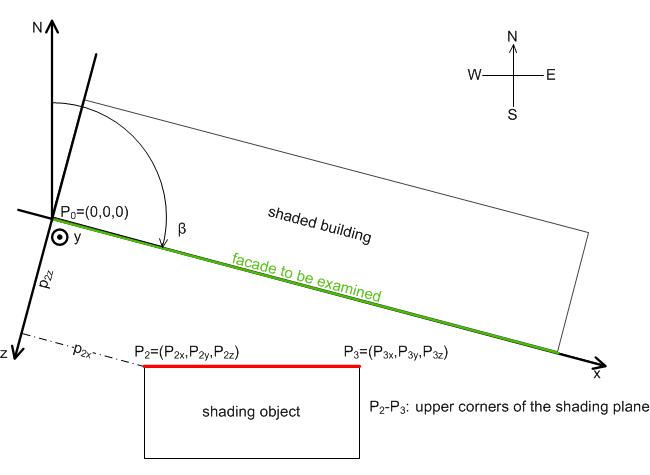
In this sketch only the upper points, P2 and P3, are illustrated due to the plan view. The lower point P1 lies underneath P2 and P4 lies underneath P3.
The input of shadow-casting ball elements is done by entering the center of the ball and its radius:
Ball elements
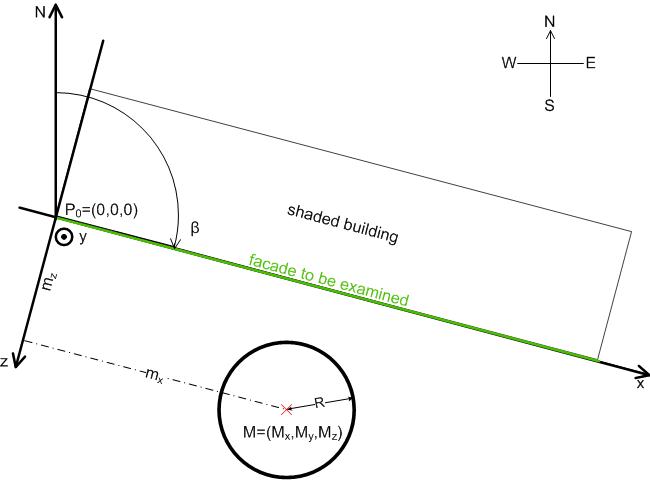
A "classification" of the ball element as in the case of the angular building is of course unnecessary, since the shadow cast by a ball changes only its direction, but not its size.